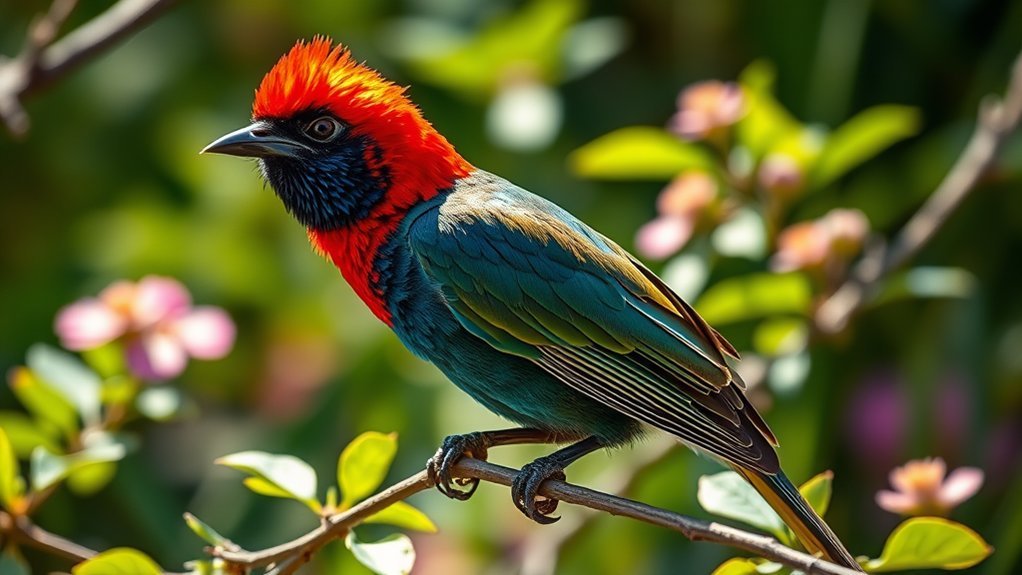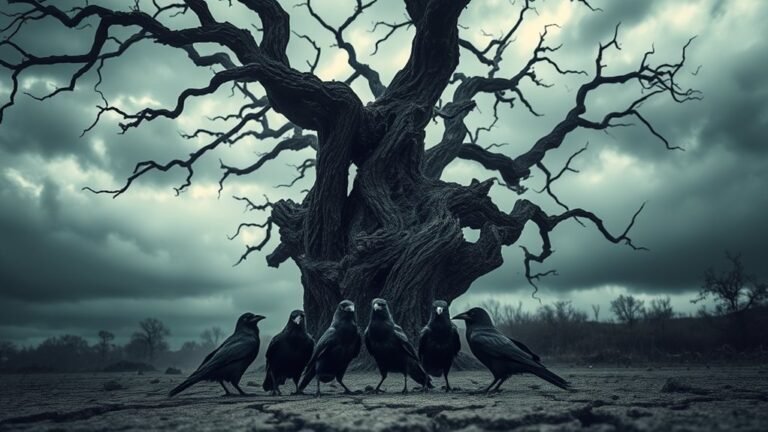Birds With Red Heads: a Fascinating Species Guide
Birds with red heads have unique traits that attract attention. Species like the Red-Headed Woodpecker and the Northern Cardinal show bright feathers. These colors help them in various ways, including attracting mates and finding food. By learning about these birds, we can better understand their environment and the challenges they encounter. Exploring their features and needs can change how you view these amazing animals.
Key Takeaways
Red-headed birds, like the Scarlet Tanager and Northern Cardinal, display bright colors to attract mates and claim territory. The Red-Headed Woodpecker lives in open woodlands and old forests and is known for its unique drumming sounds. The northern cardinal sings a joyful tune and helps spread seeds in its ecosystem. Ruby-Crowned Kinglets are small, active birds that hunt for insects in dense forests and often form mixed flocks for socializing. Protecting red-headed bird species is crucial. Efforts focus on preserving their habitats and involving communities in conservation.
Overview of Red-Headed Birds

Red-headed birds are known for their bright colors and interesting behaviors. Their vivid plumage helps them attract mates and defend their territory. Birds like the Scarlet Tanager and Red-headed Woodpecker are great examples of this vibrant red coloration, captivating bird-watchers and researchers.
These birds prefer different habitats, such as thick forests or open woodlands. Understanding where they live helps us learn how they survive and interact with others.
The Red-Headed Woodpecker
The Red-headed Woodpecker is easy to spot due to its bright red head. This bird lives in open woods, old forests, and parks. It shows adaptability in different environments.
You can identify its behavior through its distinct drumming sounds and calls, which it uses to mark its territory and attract partners. This woodpecker is agile as it searches for food on trees.
It also creates holes in trees that other birds and animals can use for nesting. By appreciating these woodpeckers, we connect with nature and understand the need to protect their habitats.
Northern Cardinal: A Flash of Red

The Northern Cardinal is a striking bird known for its bright red feathers. You can see this bird in gardens, woodlands, parks, and suburban backyards.
Its cheerful song and unique call make it a joy to have around. Male cardinals often sing to defend their territory and attract mates.
These birds help their ecosystems by spreading seeds. If you create a bird-friendly garden, you can enjoy watching these colorful cardinals and appreciate their lively presence in your space.
Red-Crowned Parrots: Colorful Companions
Red-Crowned Parrots are vibrant and intelligent birds. They aren't just beautiful; they need attention and care.
To bond with these parrots, it's important to understand their behavior. They thrive on interaction and mental stimulation. Engage them with toys, training, and socialization.
Caring for a parrot means creating an environment similar to their natural habitat. Change their toys often and provide a varied diet to improve their well-being.
As you care for your Red-Crowned Parrot, you'll gain a delightful companion that brings joy and enhances your life.
The Flame-Headed Tanager

Flame-Headed Tanagers are captivating birds known for their bright colors and lively actions. They've vibrant orange-red heads and bright yellow bodies. You can see them in the forests of Central and South America, especially in humid, tropical areas.
These birds typically stay in the understory where they look for fruits and insects. Their quick movements and cheerful songs make it easy to spot them in small groups.
Watching Flame-Headed Tanagers interact with each other reveals much about their social lives. This experience is rewarding for birdwatchers and nature lovers.
Tracking these birds in their habitat can deepen your appreciation for nature. Don't miss the chance to observe these beautiful birds in action.
House Finch: A Common Visitor
The House Finch is a common bird in cities and suburbs. It has a red head and sings a cheerful song. These birds like to nest in safe spots, such as eaves and hanging planters, showing they can adapt well to different environments.
They build their nests using plant materials and scraps, showing their cleverness.
House Finches eat a variety of foods, mainly seeds, fruits, and flowers. You can see them foraging in gardens or at feeders, where they communicate with each other using clear calls.
They bring joy to your surroundings and help you connect with nature, making moments spent with them enjoyable and memorable.
The Scarlet Macaw
Birdwatchers may find the Scarlet Macaw a vibrant and interesting companion. These beautiful birds live in tropical rainforests in Central and South America. Their bright colors stand out against the greenery of their habitat.
Scarlet Macaws have strong social bonds. They form close relationships with their mates and show affection in their interactions. They're also intelligent and can solve problems. For example, they use tools to get food.
These birds communicate in various ways, making their social interactions rich and engaging. By learning about their behaviors and habitats, you can gain a deeper appreciation for these magnificent creatures and the diverse ecosystems they inhabit.
Red-Headed Barbet: A Unique Songbird
The Red-Headed Barbet is a songbird with a striking red crown and beautiful calls. This bird lives in subtropical and tropical moist lowland forests. It enjoys areas filled with fruit-bearing trees, as these make up a large part of its diet.
The Red-Headed Barbet feeds by pecking at fruits and insects, showing its ability to adapt. It nests in tree cavities and helps the environment by spreading seeds.
Watching this bird enhances your understanding of biodiversity and the relationships in nature.
Cardinal Grosbeak: Blending Beauty With Strength
Cardinal Grosbeaks are known for their bright red feathers and strong build. They thrive in woods and gardens, where they find plenty of food.
Their strong, cone-shaped beaks help them crack seeds easily. These birds are social and often seen in flocks outside of breeding season.
Their beautiful songs add richness to their surroundings. Understanding these features shows how Cardinal Grosbeaks combine beauty and strength, making them an important part of nature.
The Ruby-Crowned Kinglet
The Ruby-Crowned Kinglet is a small bird known for its bright red crown and lively behavior. Here are some key details about this charming species:
- Foraging Habits: Ruby-Crowned Kinglets eat insects and spiders. They often search through leaves and branches to find food.
- Breeding Grounds: They build their nests in dense, coniferous forests, which provide the cover they need for safety.
- Social Behavior: These birds are friendly and enjoy being around others. They often join mixed flocks with different bird species.
- Migration Patterns: Ruby-Crowned Kinglets migrate during certain seasons, showing how well they adapt to changes in their environment.
Understanding these traits helps you appreciate the Ruby-Crowned Kinglet's important role in nature and connect more deeply with the outdoor world.
Red-Shouldered Hawk: Majestic Predators
The Red-Shouldered Hawk is a notable bird of prey recognized by its reddish-brown shoulders and loud call heard in wooded areas.
These hawks are skilled hunters. They use soaring flights and quick dives to capture small mammals and birds. Their excellent eyesight helps them spot prey from far away.
Red-Shouldered Hawks build their nests high in deciduous trees. They use sticks and other materials for construction.
Each year, they often return to the same nesting site, reinforcing their bond with the territory. This connection to their habitat is vital for their survival and highlights their role in the ecosystem.
Spotting Tips for Red-Headed Birds
To spot red-headed birds, concentrate on their habitats and behaviors. Here are some key factors to consider:
- Habitat Preferences: Search for these birds in open woodlands, parks, and wetlands. These areas are where they commonly live.
- Feeding Behaviors: Watch for their feeding habits. Many red-headed species eat insects or plant material.
- Time of Day: Look for activity early in the morning or late in the afternoon. These times are when they're most active.
- Call and Song: Learn their distinct calls. This can help you find them by sound.
By focusing on these aspects, you can improve your chances of spotting red-headed birds and enjoy the experience more.
Happy birdwatching!
Conservation Status of Red-Headed Species
Watching red-headed birds can be exciting. However, it's vital to know their conservation status. Many red-headed species face dangers, and we must pay attention to their populations.
Conservation efforts aim to protect their habitats so these birds can thrive. For example, preserving wetlands and forests helps species like the Red-Headed Woodpecker.
Community involvement in conservation projects raises awareness and improves ecosystems. You can help by participating in citizen science and supporting wildlife organizations.
Keeping informed about the status of red-headed species is essential for connecting with our ecosystems, leading to a rewarding experience in wildlife conservation.
Frequently Asked Questions
What Attracts Birds to Have Red Heads?
Red heads in birds often indicate that the bird is ready to mate and is healthy. This bright color signals good genes to potential partners. It also helps scare off predators. Recognizing this importance can help you understand bird behaviors better.
How Can I Differentiate Male and Female Red-Headed Birds?
To tell the difference between male and female red-headed birds, look at their color and behavior. Males usually have brighter colors, making them stand out more. Females tend to have softer, muted colors. Pay attention to their mating displays as well. Males often perform elaborate displays to attract females. Observing these traits can improve your birdwatching experience and make it more enjoyable.
Do Red-Headed Birds Migrate or Stay Year-Round?
Red-headed birds show different migration patterns. Some species migrate to warmer areas during winter. Others stay in their habitats year-round. By observing these birds, you can appreciate their flexibility and behavior.
What Do Red-Headed Birds Typically Eat?
Red-headed birds typically eat seeds, fruits, and insects. These food preferences help them thrive in various environments. Their ability to adapt highlights the need for habitat conservation to support their survival.
Are Red-Headed Birds Endangered or Threatened Species?
Red-headed birds have different conservation statuses. Some of these birds are threatened by habitat loss. It is important to stay informed about these species. Their survival relies on our actions to preserve their natural habitats and support conservation efforts. Let's work together to protect them.

Kashvi is a passionate bird enthusiast and nature lover who has been fascinated by the world of birds for years. With a keen eye for detail and a love for learning, Kashvi is dedicated to sharing her knowledge and insights with fellow bird enthusiasts on Avian Enthusiasts. Through her engaging and informative articles, Kashvi aims to inspire others to join her in exploring the fascinating world of birds and to promote a deeper appreciation for these incredible creatures.







